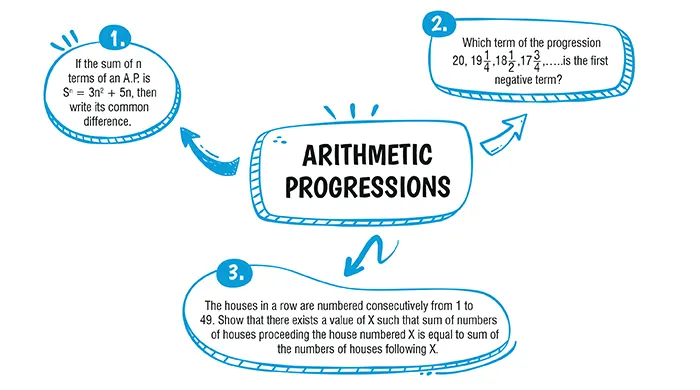Table of Contents

Ans. (c)
Explanation:
The given A.P. is
1, 3, 5, 7, 9, 11, 13, 15, 17, 19, 21, 23, 25, 27, 29, 31, 33, 35, 37, 39
Thus, a = 1, d = 2 and n = 20
We know that,
S_n = \dfrac{n}{a}[2a + (n - 1)d ] \\[4.5 bp]
= \dfrac{20}{2}[2(1) + (20 - 1)2 ] \\[4.5 bp]
= 10[2+38] = 400
Ans. (b)
Explanation:
Multiples of 4 lying between 10 and 250 are 12 , 16, 20, 24……, 248
Here, a = 12, d = 16 - 12 = 4, a_n = 248
a_n = a + (n - 1)d
⇒ 248 = 12 + (n - 1)× 4
⇒ 248 - 12 = 4(n - 1)
⇒ \frac{236}{4} = n – 1
⇒ n - 1 = 59
∴ n = 59 + 1 = 60
Explanation:
We have,
S_n = 3n^2 +5n \\[4.5 bp]
⇒\space\space\space\space S_{n - 1} = 3(n - 1)^2 + 5(n - 1) \\[4.5 bp]
=\space\space\space\space 3(n^2 + 1 - 2n) + 5n - 5 \\[4.5 bp]
=\space\space\space\space 3n^2 + 3 - 6n + 5n - 5 \\[4.5 bp]
=\space\space\space\space 3n^2 - n - 2 \\[4.5 bp]
\text{General term of A.P. is given as,} \\ [4.5 bp] \space\space\space\space
T_n = S_n - S_{n-1} \\[4.5 bp]
\space\space\space\space= 3n^2 + 5n - 3n^2+ n + 2 \\[4.5 bp]
\space\space\space\space= 6n + 2 \\[4.5 bp]
\text{ Putting n = 1,2,3, we get }\\ [4.5 bp] \space\space\space\space
T_1 = 6 × 1 + 2 = 8 \\[4.5 bp]
\space\space\space\space T_2= 6 × 2 + 2 = 14 \\[4.5 bp]
\space\space\space\space T_3 = 6 × 3 + 2 = 20 \\[4.5 bp]
\text{Now,} \space\space\space\space\space T_2 - T_1 = 14 - 8 = 6 \\[4.5 bp]
\text{and} \space\space\space\space\space T_3 - T_2 = 20 - 14 = 6
∴ common difference = 6
Explanation:
Given, A.P. is 20, 19\dfrac{1}{4}, 18\dfrac{1}{2}, 17\frac{3}{4},….. \\[4.5 bp]
= 20, \dfrac{77}{4}, \dfrac{37}{2}, \dfrac{71}{4}, \\[4.5 bp]
\text{Here,} \space a = 20, d = \dfrac{77}{4} – 20 = \dfrac{77 – 80}{4} = \dfrac{–3}{4} \\[4.5 bp]
\text{Let} \space a_n \space \text{ be its first negative term}\\[4.5 bp]
\space\space\space\space\space a_n\space < 0 \\[4.5 bp]
\text{Then} \space\space\space\space \space a_n + (n – 1)d < 0. \\[5.5 bp]
\Longrightarrow \space\space\space\space\space
20+(n – 1)\left(–\dfrac{3}{4}\right) < 0 \\[5.5 bp]
\Longrightarrow \space\space\space\space\space 20 \space – \space \dfrac{3}{4}n + \dfrac{3}{4} < 0 \\[5.5 bp]
\Longrightarrow\space\space\space\space\space 20 + \dfrac{3}{4} < \dfrac{3}{4}n \\[5.5 bp]
\Longrightarrow\space\space\space\space\space \dfrac{83}{4} < \dfrac{3}{4}n \\[5.5 bp]
\Longrightarrow\space\space\space\space\space n > \dfrac{83}{4} × \dfrac{4}{3} \\[5.5 bp]
\Longrightarrow\space\space\space\space\space n > \dfrac{83}{3} = 27.66...
28th term will be the first negative term of given A.P.
Explanation:
Given, the houses in a row numbered consecutively from 1 to 49.
Now, sum of numbers preceding the number X
Hence, at X = 35, sum of number of houses preceding the house no. X is equal to the sum of the number of houses following X.
| Chapter No. | Chapter Name |
|---|---|
| Chapter 1 | Real Numbers |
| Chapter 2 | Polynomials |
| Chapter 3 | Pair of Linear Equations in Two Variable |
| Chapter 4 | Quadratic Equations |
| Chapter 5 | Arithmetic Progressions |
| Chapter 6 | Triangles |
| Chapter 7 | Coordinate Geometry |
| Chapter 8 | Introduction to Trigonometry |
| Chapter 9 | Some Applications of Trigonometry |
| Chapter 10 | Circles |
| Chapter 11 | Areas Related to Circle |
| Chapter 12 | Surface Areas and Volumes |
| Chapter 13 | Statistics |
| Chapter 14 | Probability |
| Chapter Wise Important Questions for CBSE Board Class 10 Maths |
|---|
| Real Numbers |
| Polynomials |
| Pair of Linear Equations in Two Variables |
| Quadratic Equations |
| Arithmetic Progressions |
| Triangles |
| Coordinate Geometry |
| Introduction to Trigonometry |
| Some Applications of Trigonometry |
| Circles |
| Areas Related to Circles |
| Surface Areas and Volumes |
| Statistics |
| Probability |
CBSE Important Questions Class 10
ICSE Important Questions Class 10
CBSE Important Questions Class 10
ICSE Important Questions Class 10